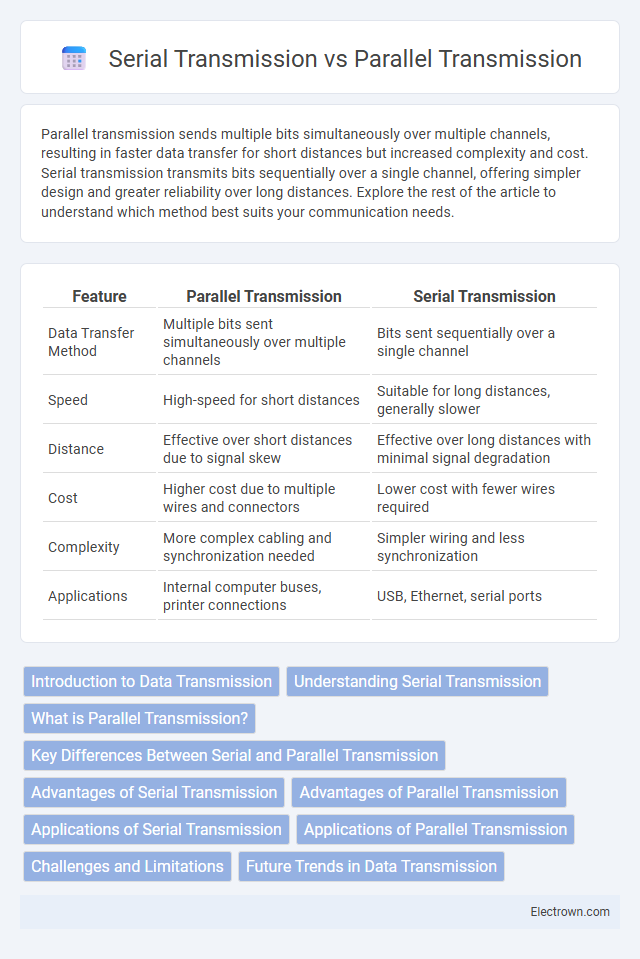Parallel transmission sends multiple bits simultaneously over multiple channels, resulting in faster data transfer for short distances but increased complexity and cost. Serial transmission transmits bits sequentially over a single channel, offering simpler design and greater reliability over long distances. Explore the rest of the article to understand which method best suits your communication needs.
Table of Comparison
| Feature | Parallel Transmission | Serial Transmission |
|---|---|---|
| Data Transfer Method | Multiple bits sent simultaneously over multiple channels | Bits sent sequentially over a single channel |
| Speed | High-speed for short distances | Suitable for long distances, generally slower |
| Distance | Effective over short distances due to signal skew | Effective over long distances with minimal signal degradation |
| Cost | Higher cost due to multiple wires and connectors | Lower cost with fewer wires required |
| Complexity | More complex cabling and synchronization needed | Simpler wiring and less synchronization |
| Applications | Internal computer buses, printer connections | USB, Ethernet, serial ports |
Introduction to Data Transmission
Data transmission involves transferring digital or analog data between devices using various communication methods. Parallel transmission sends multiple bits simultaneously over multiple channels, enhancing speed but increasing complexity and cost. Serial transmission transmits bits sequentially over a single channel, offering simplicity and reliability for long-distance communication.
Understanding Serial Transmission
Serial transmission transfers data bits sequentially over a single channel, optimizing long-distance communication by minimizing signal degradation and electromagnetic interference. It uses fewer wires compared to parallel transmission, making it cost-effective and simpler for connecting devices like USB and SATA interfaces. The efficient timing and synchronization mechanisms in serial transmission enhance data integrity and transfer rates, especially in high-speed communication environments.
What is Parallel Transmission?
Parallel transmission involves sending multiple bits simultaneously across multiple channels or wires, enabling faster data transfer compared to serial transmission. Typically used in short-distance communication such as within computer components like buses and memory modules, parallel transmission can achieve higher data rates due to its simultaneous signal transfer. However, signal timing and synchronization challenges limit its effectiveness over long distances, where serial transmission becomes more reliable.
Key Differences Between Serial and Parallel Transmission
Serial transmission sends data one bit at a time over a single channel, ensuring simpler wiring and longer transmission distances with reduced crosstalk and signal degradation. Parallel transmission transmits multiple bits simultaneously across multiple channels, enabling faster data transfer rates but increasing the risk of signal skew and electromagnetic interference. Your choice between the two depends on the required speed, distance, and complexity of the communication system.
Advantages of Serial Transmission
Serial transmission offers significant advantages such as reduced cabling complexity and lower cost compared to parallel transmission. It enables longer distance data transfer with minimal signal degradation and electromagnetic interference, ensuring reliable communication. Your systems benefit from enhanced data integrity and simpler synchronization due to single data line usage.
Advantages of Parallel Transmission
Parallel transmission offers significant speed advantages by sending multiple bits simultaneously over multiple channels, making it ideal for short-distance communication such as within computer buses or peripheral interfaces. This method reduces latency and enhances data transfer rates compared to serial transmission, which transmits bits sequentially. Furthermore, parallel transmission allows for simpler synchronization and error detection, improving overall reliability in data communication.
Applications of Serial Transmission
Serial transmission is widely used in applications requiring long-distance communication and data transfer, such as USB connections, Ethernet networking, and telecommunications. It efficiently transmits data bit by bit over a single channel, reducing the complexity and cost of cables compared to parallel transmission. Your devices benefit from serial transmission's reliability and speed, especially in scenarios involving serial ports, modems, and fiber optic communication.
Applications of Parallel Transmission
Parallel transmission is commonly used in applications requiring high-speed data transfer over short distances, such as connecting a computer to a printer via a parallel port or within internal computer buses like the data bus linking the CPU to memory. You benefit from its ability to transmit multiple bits simultaneously, enabling faster communication in devices where synchronization and cable length are manageable. Industrial machinery and embedded systems also employ parallel transmission for real-time data acquisition due to its low latency and simplicity in hardware design.
Challenges and Limitations
Parallel transmission faces challenges such as signal degradation and crosstalk due to multiple simultaneous data paths, limiting transmission distance and speed. Serial transmission overcomes these issues with simpler wiring and reduced electromagnetic interference, but it may experience latency and lower throughput in comparison. Your choice between parallel and serial transmission must consider the application's distance, data rate requirements, and hardware complexity.
Future Trends in Data Transmission
Future trends in data transmission emphasize higher speeds and greater efficiency through the adoption of advanced serial transmission technologies, which minimize signal degradation over longer distances compared to parallel transmission. Optical fiber and 5G wireless networks leverage serial protocols to support massive data throughput and low latency essential for emerging applications like AI and IoT. You can expect continued advancements in serial transmission standards, such as PCIe 6.0 and USB4, to dominate future hardware interfaces by delivering faster and more reliable data transfer.
Parallel vs Serial Transmission Infographic

 electrown.com
electrown.com